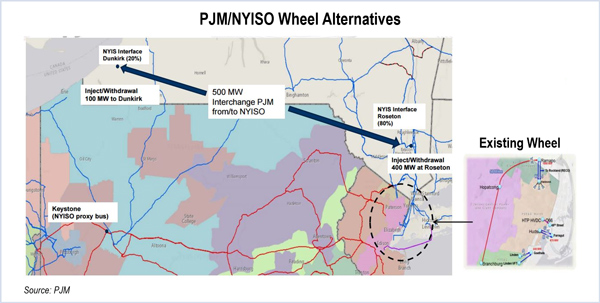By Rory D. Sweeney
VALLEY FORGE, Pa. — A power-flow analysis indicates a reduced version of the current flow pattern is the most reliable resolution when the Con Ed-PSEG ‘wheel’ ends on April 30, PJM and NYISO officials said last week.
The grid operators are recommending an “operational base flow” that continues to route 400 MW from upstate New York to New York City through northern New Jersey, a reduction from the 1,000 MW in the current wheel.
Consolidated Edison decided not to renew the wheel arrangement — which it used to move power from upstate New York through Public Service Electric and Gas facilities in northern New Jersey to serve its load in New York City — in a transmission cost allocation dispute. (See PJM, NYISO Seek Input on Replacing Con Ed-PSEG ‘Wheel’.)
To ensure operational flexibility during emergencies, the analysis used three “extreme” cases that focused on high load and high interchange and included 16 scenarios for various interchange distribution options, PJM’s Phil D’Antonio told the Operating Committee last week. It assumed 2,500 MW in exports to NYISO and 1,500 MW in imports to PJM, which are the historical maximums, he said. The analysis applied various percentage distributions of AC interchange on the eastern interfaces (5018, JK and ABC) to determine impacts, feasibility and operational flexibility.
The eight phase-angle regulators (PARs) involved in the analysis were fixed in their pre-existing positions during an initial analysis to determine the percentage of AC interchange that flows over the eastern interfaces. “We didn’t adjust any PARS in the analysis,” D’Antonio said. “We adjusted generation to determine what the flows were.”
Limitations
The analysis identified limitations both in delivering from NYISO to PJM on three lines (A, B and C) between New York City and northern New Jersey, and from PJM to NYISO on two lines (J and K) between Waldwick in northern New Jersey and Ramapo in upstate New York — a reverse of the existing wheel flows. Limitations included exhausted PAR taps, congestion in northern New Jersey and forcing flow from a 230-kV system at Waldwick to a 345-kV system at Ramapo. That system difference seems to be “the most limiting” factor from PJM’s perspective, D’Antonio said. NYISO also found delivery issues on the A, B and C lines using an N-1-1 analysis, he said.
PJM is considering a combination solution that first accounts for the operational base flow and then applies a percentage of the remaining interchange distribution. The J and K lines would shoulder 15%, while A, B and C would receive 21%. Line 5018, a 500-kV span between Ramapo and Branchburg in central New Jersey would receive 32%, and the remaining 32% would continue to flow on several western ties that cross the Pennsylvania-New York border as currently happens.

The flows would remain largely the same, but at reduced levels. A study of that option set an operational base flow bandwidth on the J/K and A/B/C lines between 300 MW and 500 MW. That option allowed the grid operators to meet their target flows and adhere to protocols, D’Antonio said.
No Surprise
“I don’t think that should come as a surprise to anybody [that] for 30-plus years we’ve been upgrading the Public Service North system with respect to the nonconforming wheeling service, so physically that’s naturally what the system would want to do outside of trying to force flows using the PARs,” D’Antonio said.
From a market perspective, maintaining a full -1000/1000 operational base flow creates the least additional congestion costs at 1.16%. The -400/400 option creates about 50% more at 1.8%, while the strict 0/0 creates the most at 2.14%. All three options are comparable in the productions costs and load payments they create.
Dave Pratzon of GT Power Group asked if NYISO is planning to reinforce its side of the system to better balance the flows now that Con Ed will no longer pay to maintain the wheel.
Several stakeholders have voiced concerns that the proposed solution provides benefits to Con Ed similar to the existing situation but absolves the utility from any responsibility for transmission upgrades. “A lot of people see … New York continuing to lean on PJM’s transmission system,” Pratzon said.
At a joint PJM/NYISO meeting Friday, NYISO reiterated its position that the proposed solution officially canceled the wheel, even if the flows continue.
NYISO will seek stakeholder approval for the joint operating agreement changes before a planned FERC filing in November. The RTOs are targeting the first quarter of 2017 for training and implementation of the new protocols.
─ William Opalka contributed to this report.




